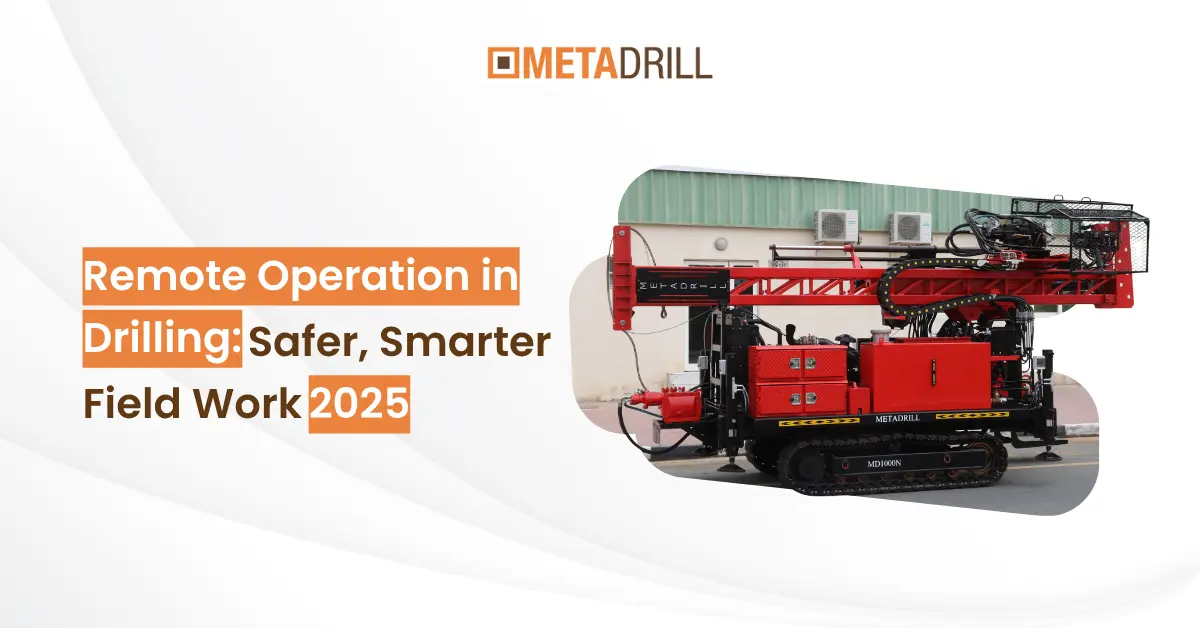
Remote operation puts expert eyes and hands on the rig without crowding the pad. For the UAE’s busy sites, it means fewer people in harm’s way, faster diagnostics, and steadier meters. Here’s how Remote Operation in Drilling works – methods, tools, timelines—and how Metadrill drilling company customers can plan it into exploration drilling.
Early proof point: In a cross-industry “digital oilfield” survey, remote asset operations ranked as the highest-ROI use case, ahead of nine other applications, validation that remote models create tangible value.
What “Remote Operation in Drilling” Really Means
Running parts of your drilling workflow from a control room, nearby or off-site – using live data, two-way comms, and controlled intervention. For exploration drill rigs, it usually includes remote viewing, advisory control, and, where permitted, supervised automation of certain functions.
Why it matters in 2025
Safety: fewer bodies on the pad; lower exposure to rotating equipment and fluids.
Uptime: faster fault finding; experts can “drop in” virtually across multiple rigs.
Quality: consistent parameter control improves sample integrity in exploration drilling.
Core Methods You Can Deploy
Tiered remote operation model
Tier 1: Remote visibility (see everything)
Multi-angle CCTV and mast cams
On-rig dashboards (RPM, torque, WOB, pullback, pump pressure, flow)
Data logging to a central historian
Tier 2: Remote advisory (guide the crew)
Real-time coaching on bit selection, feed rates, and fluid management
Alarm management and trend interpretation from specialists
Tier 3: Supervised control (act with guardrails)
Preset envelopes for rotation/feed
Automated tripping sequences and interlocks
Exception handling routed to an on-site lead
Safety note: Tier 3 requires strong governance and clear “who owns the stop button” rules. Keep roles unambiguous and practice handover drills.
Tooling & Tech Stack
Sensing and data backbone
Sensors: torque, RPM, pressure, temperature, vibration—calibrated and timestamp-aligned.
Networking: hardened LTE/5G or site fiber; QoS for control traffic.
Edge compute: buffer data, run local rules if the link drops.
Cyber basics: VPN, MFA, role-based access, immutable logs.
Operator interface
Control room HMI: trends, alarms, replay, and “last 5 minutes” buffers.
Video wall: rig floor, rod handler, pumps, return line, site perimeter.
Playbooks: SOPs for stick-slip, pack-off, lost circulation, and refusals.
Rig-side upgrades for exploration drill rigs
Safe rod-handling aids and interlocked guards
Auto-lubrication and smart shutdowns
Remote-ready drilling rig equipment (actuators with feedback)
Planning & Timelines
30-60-90 day road map
Days 0–30: Baseline and quick wins
Map hazards and tasks worth “de-manning.”
Fit cameras and streaming dashboards; standardize tags.
Pilot Remote Operation in Drilling on one shift with observers.
Days 31–60: Advisory at scale
Expand to multi-rig support; add alarm rationalization.
Train crews on remote call-down etiquette and fail-safe states.
Start a daily “remote ops stand-up” (10 minutes, metrics + issues).
Days 61–90: Supervised control (selected steps)
Introduce guarded set-points for feed/rotation on candidate holes.
Dry-run emergency scenarios; validate stop-authority and comms.
Audit data quality; lock change management.
Field Playbook (How to Keep It Safe and Useful)
Five habits for rig teams
One channel for control: radio discipline; no conflicting commands.
Red team drills: simulate link loss and force a safe reversion.
Camera hygiene: keep lenses clean; inspect blind spots daily.
Parameter guardrails: publish max/min tables near the panel.
Post-run reviews: replay anomalies; update the playbook.
Quality for exploration drilling
Stabilize feed to protect core; watch return flow for cuttings changes.
Use replay to compare “good runs vs. bad runs” and tune drilling rig equipment.
Track bit hours and string health; let data lead drilling tools swaps.
Where Metadrill drilling company Fits In
What to expect from a rig partner
A rig builder should make remote-readiness practical: sensor-rich heads, clean data models, CCTV mounts, safe rod-handling, and documentation your HSE team can adopt. The Metadrill drilling company approach emphasizes site-ready upgrades for exploration drill rigs so you can scale remote practices without slowing the yard.
Procurement & Governance
Choose tech you can live with
Avoid proprietary dead-ends; demand open data exports.
Validate spares and service locally.
Confirm latency budgets for any supervised actions.
Roles, rights, and records
Write a RACI: who watches, who advises, who commands.
Keep a secure audit trail of set-point changes and overrides.
Align with client and regulator expectations before go-live.
Adoption momentum: the autonomous/remote equipment space in heavy industries is scaling, autonomous mining/drilling equipment alone is projected to grow from USD 4.48B (2024) to USD 11.86B by 2033 (11.6% CAGR), reflecting investment in safety and productivity tech.
You can also check: Wireline vs Conventional Coring: Choosing the Optimal System
Conclusion: Safer crews, steadier meters
Remote Operation in Drilling is not hype; it’s a practical way to reduce exposure, add expert coverage, and smooth performance in exploration drilling. Start with visibility (Tier 1), layer advisory (Tier 2), and add supervised control (Tier 3) where it’s justified. Choose exploration drill rigs and drilling rig equipment that are sensor-ready, write clear roles, and train handovers until they’re muscle memory. With the Metadrill drilling company as your build partner, you’ll turn remote capability into safer pads and more predictable weeks, one carefully instrumented rig at a time.
Question to the public:
Remote drilling ops cut risk and lift uptime on UAE sites. Plan sensor-ready rigs—tiers, tools, timelines, with Metadrill for safer pads & steadier meters.